Choosing a suitable flooring material is crucial with the increasing demands of modern homes and commercial spaces. Rubber flooring stands out among the myriad options available, particularly for its touted waterproof properties. But is rubber flooring genuinely waterproof, or is it merely a marketing buzzword? This article aims to explore this question in depth, providing readers with a comprehensive understanding of rubber flooring, its advantages, and practical insights for its application.
We’ll address some pressing questions as we dive into waterproof matting and rubber floors. How does rubber compare to other materials like PVC, foam, or vinyl regarding water resistance? How can one effectively maintain and enhance the waterproofing of rubber floors? Is it the right choice for laundry rooms, gyms, or patios?
Join us as we peel back the layers of rubber flooring, giving you valuable knowledge to make informed decisions for your home or business. Whether you’re considering installing rubber floors or simply curious about their features, this exhaustive guide will answer your questions.
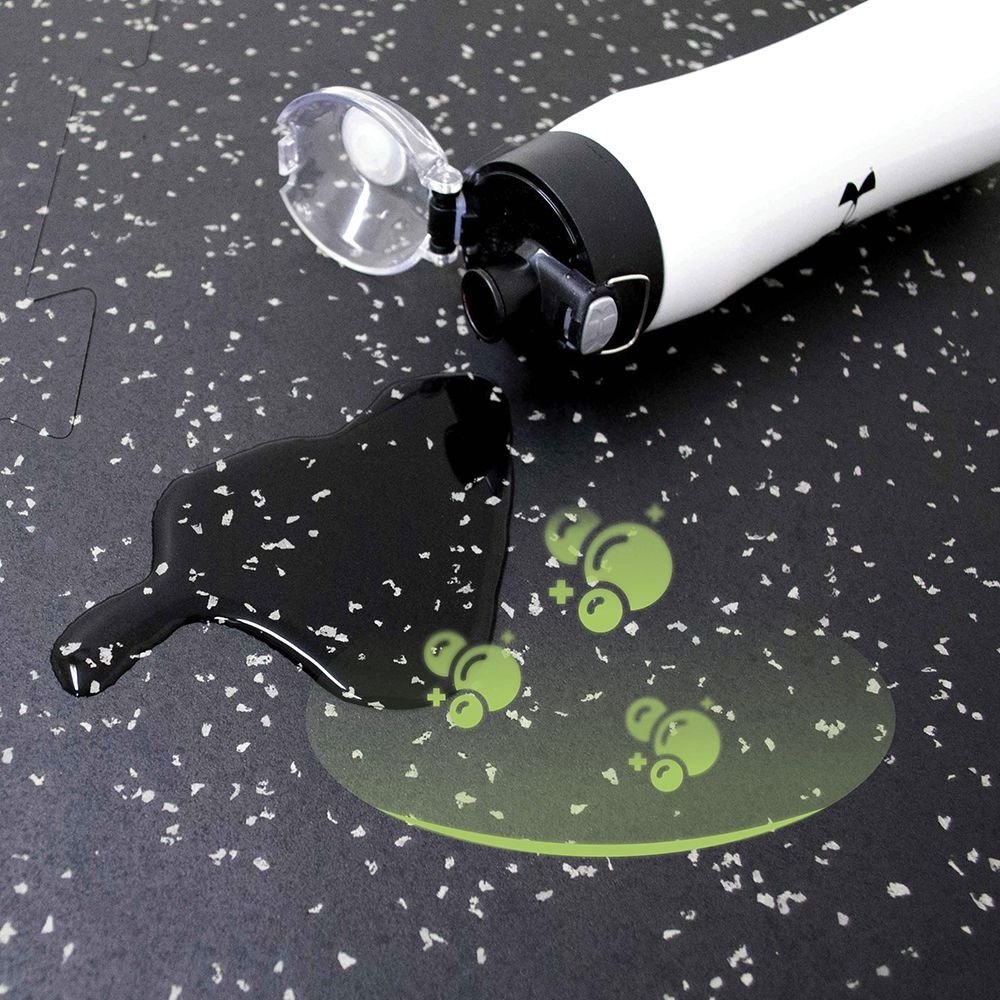
What Makes Rubber Flooring Waterproof?
Flooring materials are exposed to many elements, but water is one of the most challenging to combat. Rubber flooring, known for its resilience, boasts waterproofing as one of its prime features. But what makes rubber inherently resistant to water?
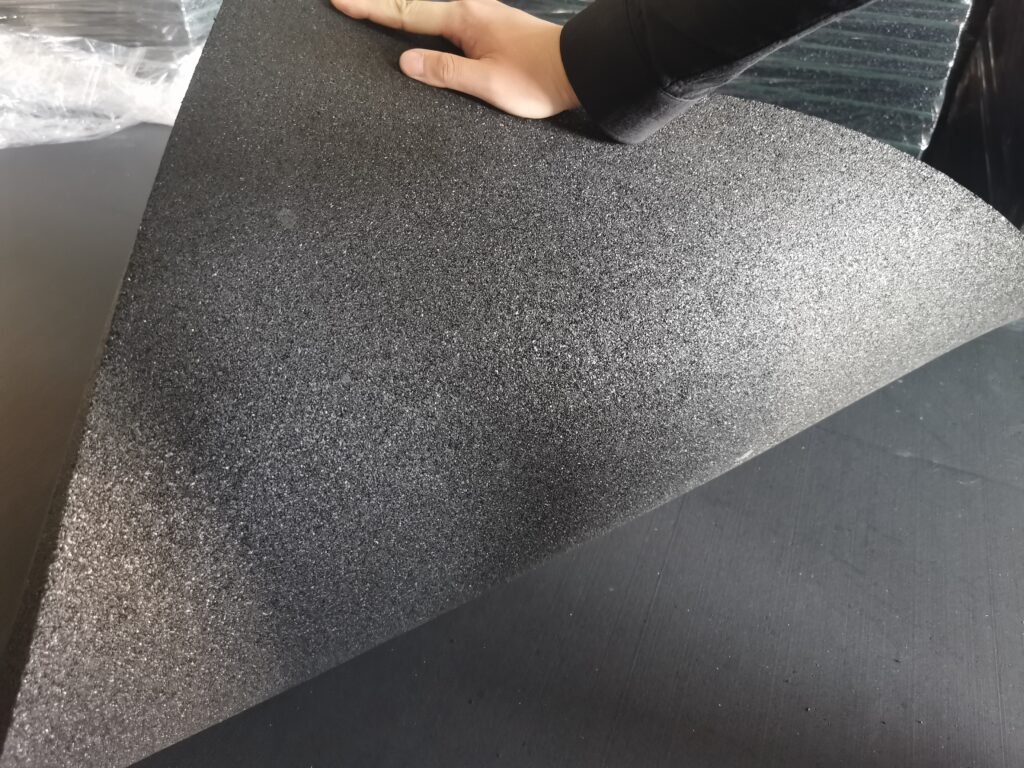
What’s the science behind waterproofing matting?
Waterproofing in flooring is achieved by preventing the penetration or absorption of water or moisture. Rubber, inherently, has a closed-cell structure. This means its microscopic cells are tightly packed and do not allow water to permeate readily. The elasticity of rubber also plays a role. When pressure is applied, rubber can flex and rebound without breaking, making it less prone to cracks and spaces that otherwise allow water infiltration. The combination of these characteristics results in a material that effectively repels water, keeping the underlying surface dry.
How does vulcanized rubber resist moisture?
Vulcanization is a process where rubber is mixed with sulfur and then heated to a high temperature. This process transforms raw rubber’s soft and sticky nature into a more durable, elastic, and water-resistant material. Vulcanized rubber has cross-linked polymer chains, enhancing its structural integrity and waterproof capabilities. This makes vulcanized rubber exceptionally resilient to various environmental factors, including moisture. It doesn’t just repel water; it stands firm against multiple liquids and chemicals, making it a popular choice for industrial and commercial settings.

Are all rubber floors made equally waterproof?
While rubber, by its nature, is water-resistant, not all rubber floors are made the same. Factors such as the quality of the rubber, the production methods, and any added materials or treatments can influence the degree of its waterproofing. For instance, mixed with other materials, recycled rubber floors might not offer the same level of water resistance as pure, virgin rubber floors. Moreover, the finish on the rubber surface, whether matte or glossy, can also play a role in its water-resisting capabilities. When considering rubber flooring, it’s essential to understand the type and quality of rubber to ensure it meets your waterproofing requirements.

Enhancing and Preserving the Waterproof Nature of Rubber Flooring
Waterproof rubber flooring is a popular choice for many homes and businesses, protecting against spills and moisture. To maximize the potential of this flooring type, specific measures can be taken to ensure its prolonged efficiency and appearance. Let’s dive into the methods of maintaining and boosting the water-resistant features of rubber flooring.
How do you seamlessly connect rubber mats for optimal waterproofing?
To create an uninterrupted, waterproof mat surface, mainly when covering larger spaces, it’s essential to join rubber mats flawlessly.
- Preparation: Clean the mat edges, ensuring no dirt or debris. This step is crucial for the adhesive to work effectively.
- Selecting the Right Adhesive: Various adhesives are available for rubber, with polypropylene plastic-based ones being a favorite. It not only forms a firm bond but also combats moisture effectively.
- Application: Spread a thin adhesive layer on the edges you merge. Align the mats perfectly and press them together.
- Curing Time: Let the adhesive settle for the recommended 24 hours before allowing any heavy traffic or exposure to wet areas.
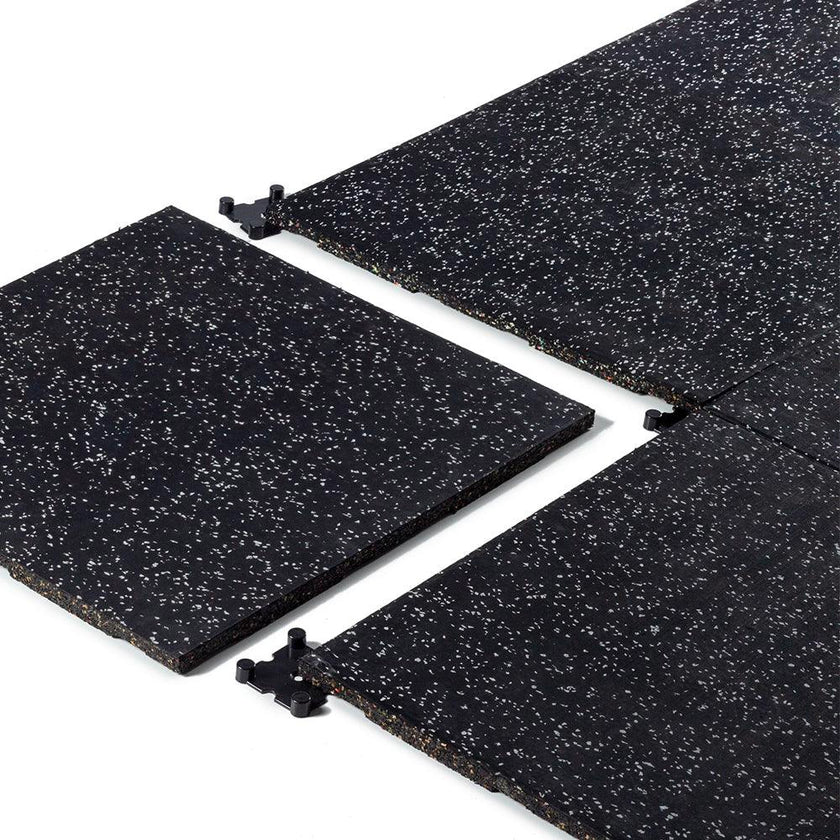
Should an additional layer be placed under rubber flooring for extra protection?
An added layer beneath waterproof mats can be beneficial for specific applications, like basements or outdoor patios, where moisture might be a matter of concern.
- Vapor Barrier: Introducing a vapor barrier underneath the rubber flooring can be ideal in places like basements prone to mold and mildew. This barrier, often made of polypropylene plastic, can prevent moisture from rising, safeguarding the rubber from potential damage.
- Cushioning: A cushioning underlay can be placed for areas like kids’ play zones or spas, where comfort and shock absorbent qualities are prized. This offers additional softness and serves as an extra moisture barrier, beneficial near pools or outdoor setups.

Are there precautions to consider when installing rubber flooring atop wood?
Laying rubber flooring over wood can enhance the water-resistant properties of wooden floors, especially in wet areas like spas or patios. However, there are precautions to be mindful of:
- Moisture Level: Before the installation, ascertain that the wooden base has minimal moisture content. Excessive dampness can lead to mold or mildew buildup beneath the waterproof mat.
- Securing the Rubber: Rubber flooring, mainly when used outdoors, needs to be well-sealed, focusing on the seams to prevent slip hazards and water seepage.
- Breathability: Since wood requires breathability, avoid adhesives that create a complete vapor lock. Choose those specifically designed for wood bases.
- Expansion and Contraction: Wood can expand or contract with temperature fluctuations. Therefore, when you install rubber atop it, ensure a slight gap exists between the rubber and the walls to accommodate this.
With the proper care and measures, waterproof rubber flooring can provide aesthetic appeal and functionality, whether for outdoor use or indoor spaces. From patios to basements, homes to commercial areas, rubber flooring’s versatility, availability in various styles and colors, and its adaptability to match diverse requirements make it a product to be proud of. Whether you’re looking to sign a deal, pick up some samples, connect with suppliers for delivery, or explore a variety of items, prices, and values, rubber flooring stands as a standard choice.
Comparing Rubber Flooring to Other Materials
As flooring options evolve, homeowners and business owners compare the benefits and drawbacks of various materials. Rubber flooring stands out for its durability and resilience, but how does it measure up against other popular flooring types? Let’s delve into the nuances of rubber flooring compared to other materials.
What is the difference between floor liners and mats?
Floor liners and mats serve similar purposes – protecting the underlying surface – but have distinct differences:
- Customization: Floor liners are typically customized to fit the specific contours and dimensions of an area, such as the floor of a vehicle. This ensures maximum coverage and protection. On the other hand, Mats come in standard sizes and can be placed anywhere, from entrances to kitchens.
- Material: While both can be made from various materials, including rubber, floor liners often have a more rigid structure, whereas mats might be more flexible and cushioned.
- Purpose: Liners often serve as a permanent or semi-permanent protective layer, while mats can be easily removed, cleaned, or replaced.
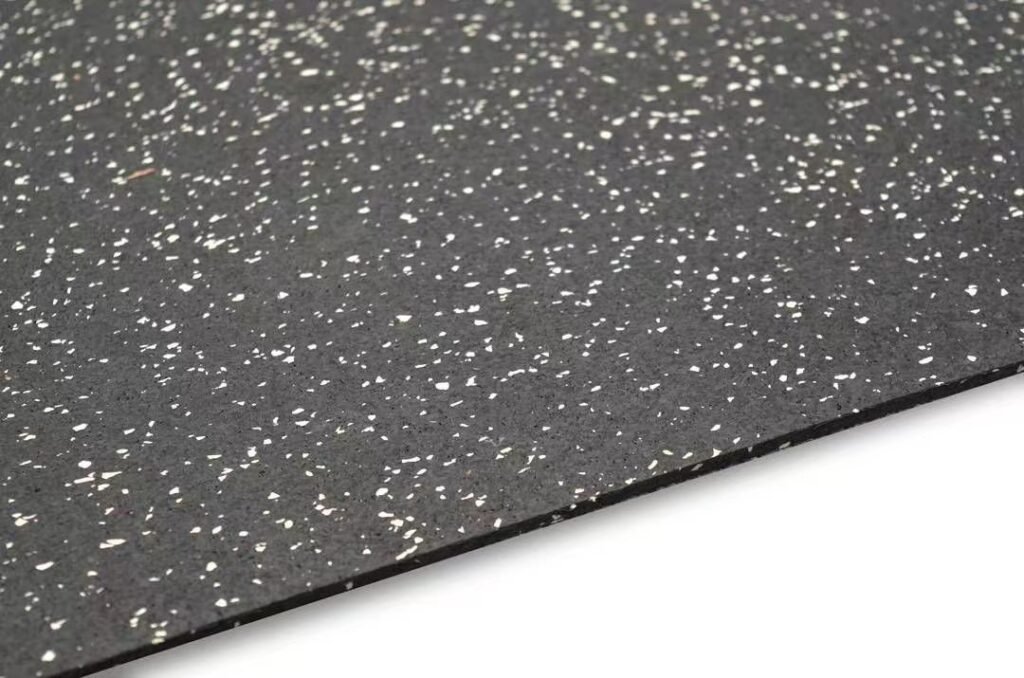
PVC floor mats vs. rubber: which is more waterproof?
Both PVC (polyvinyl chloride) and rubber are popular choices for waterproof flooring, but they have their strengths:
- PVC Floor Mats are generally waterproof, chemical-resistant, and easy to clean. They can be slightly more rigid than rubber mats and may be less environmentally friendly due to their plastic content.
- Rubber Mats: Inherently waterproof, rubber mats are also shock absorbent, making them comfortable for prolonged standing. They can be more environmentally friendly, especially if made from recycled rubber.
While both materials offer excellent waterproof capabilities, the choice often boils down to the area’s specific needs and personal preferences.

Vinyl or rubber: which is a better choice for gym flooring?
Gyms require flooring that is durable, shock-absorbent, and easy to maintain. Let’s compare vinyl and rubber for this application:
- Vinyl: Vinyl is water-resistant, easy to clean, and can mimic the appearance of other materials. However, it might not offer the same level of shock absorption as rubber, which could be a concern for heavy-duty workout areas.
- Rubber: Recognized for its excellent shock-absorbing qualities, rubber is ideal for areas with free weights or high-impact exercises. It’s also highly durable and can withstand the wear and tear of a busy gym environment.
Rubber is often the preferred choice for most gym applications due to its superior shock absorption and durability.
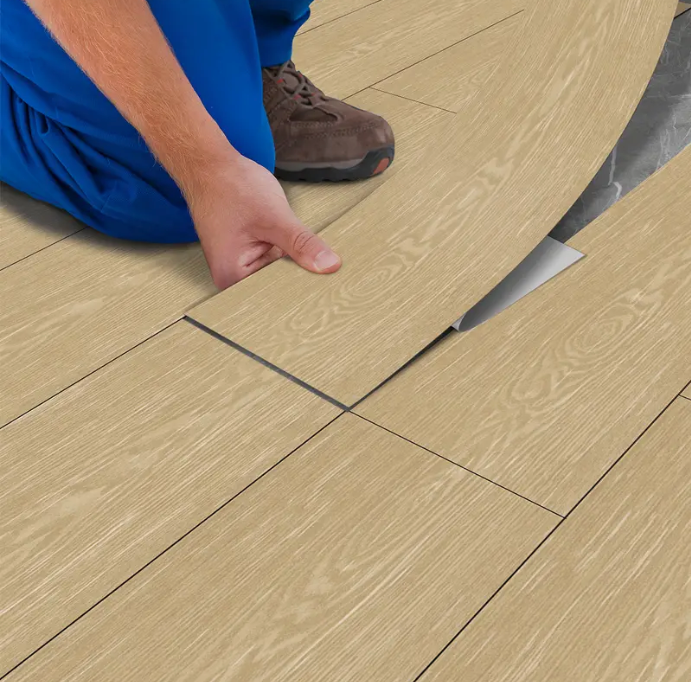
Foam flooring in wet areas: Pros and cons.
Foam flooring, particularly in wet areas, has its advantages and limitations:
Pros:
- Cushioning: Foam offers excellent cushioning, making walking or standing comfortable.
- Safety: Being slip-resistant, foam tiles can enhance safety in wet areas.
- Temperature Insulation: Foam can feel warmer underfoot than tiles, especially in colder conditions.
Cons: - Absorption: While some foam tiles are designed to be water-resistant, they can absorb moisture over time, leading to potential mold or mildew issues.
- Durability: Foam may not withstand heavy foot traffic or sharp objects as effectively as more complex materials like rubber or tiles.
- Appearance: Some may find foam tiles less aesthetically pleasing than other flooring options.
In conclusion, while rubber flooring offers many benefits, weighing its features against those of other materials is essential to finding the perfect match for each specific application.
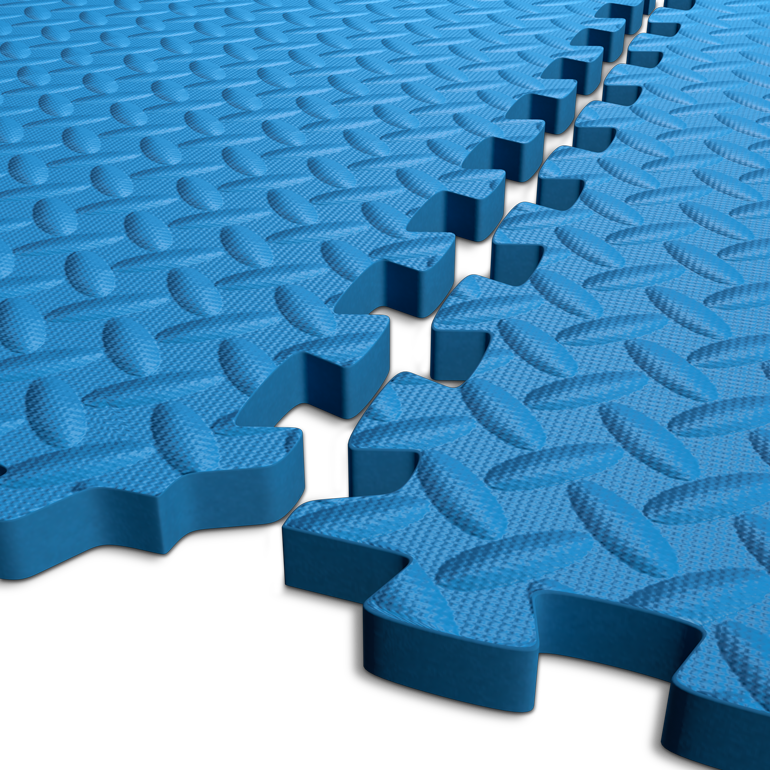
Application of Rubber Flooring in Different Areas
Rubber flooring, with its durability and water-resistant nature, finds utility in many environments. Rubber flooring might be the answer if you’re looking to waterproof a basement or need a resilient floor for your outdoor patio. Let’s delve deeper into how rubber can be a game-changer in different areas.
How do you waterproof a subfloor using rubber mats?
Waterproofing a subfloor is pivotal, especially in areas prone to moisture. Rubber mats can play an instrumental role in this:
- Clean & Prep: Ensure the subfloor is clean, dry, and debris-free.
- Measure & Cut: Measure the area to be covered and cut the rubber mats accordingly. Remember, precision is key to preventing water seepage.
- Lay & Secure: Place the rubber mats onto the subfloor. Use adhesive or double-sided tape to firmly secure them, ensuring no gaps are left between mats.
- Seal the Edges: To offer an added layer of protection, seal the edges using waterproof tape or sealants.
Employing rubber mats in this manner provides a moisture barrier and adds an extra layer of insulation.
What makes rubber the ideal choice for a laundry room floor?
Laundry rooms are often subject to spills, moisture, and wear from heavy appliances. Here’s why rubber flooring is ideal:
- Water Resistance: Rubber is inherently water-resistant, making it perfect for areas where water spills occur daily.
- Durability: It can withstand the weight and vibration of washing machines and dryers without deteriorating.
- Noise Reduction: The cushioned nature of rubber can dampen the noise from appliances, creating a quieter environment.
- Ease of Maintenance: Spills from detergents or bleach can be easily wiped up without causing damage or leaving stains.

Is gym flooring waterproof and suitable for basements?
Yes, rubber gym flooring offers multiple benefits for basement applications:
- Moisture Protection: Basements below ground level are prone to moisture. Rubber flooring’s waterproof nature makes it ideal for such conditions.
- Shock Absorption: Essential for gym activities, rubber cushions the impact, protecting both the user and the equipment.
- Temperature Regulation: Rubber acts as an insulator, ensuring the basement doesn’t get too cold, especially during winter.
- Durability: Given the rigorous activities in gyms, the durability of rubber ensures longevity without frequent replacements.

Can rubber mats be effectively used outdoors?
Absolutely! Rubber mats are versatile and cater to outdoor uses effectively:
- Weather Resistance: Rubber can withstand various weather conditions – from the scorching heat to icy winters, without deteriorating.
- Safety: Its slip-resistant nature ensures safety, especially in wet conditions.
- UV Resistant Varieties: Some rubber mats resist UV, ensuring they don’t fade or degrade under sunlight.
- Maintenance: Rubber mats are easy to clean, even when subjected to outdoor dirt and debris.
In conclusion, the versatility of rubber flooring makes it suitable for diverse applications, from indoor spaces prone to moisture to outdoor areas exposed to the elements.
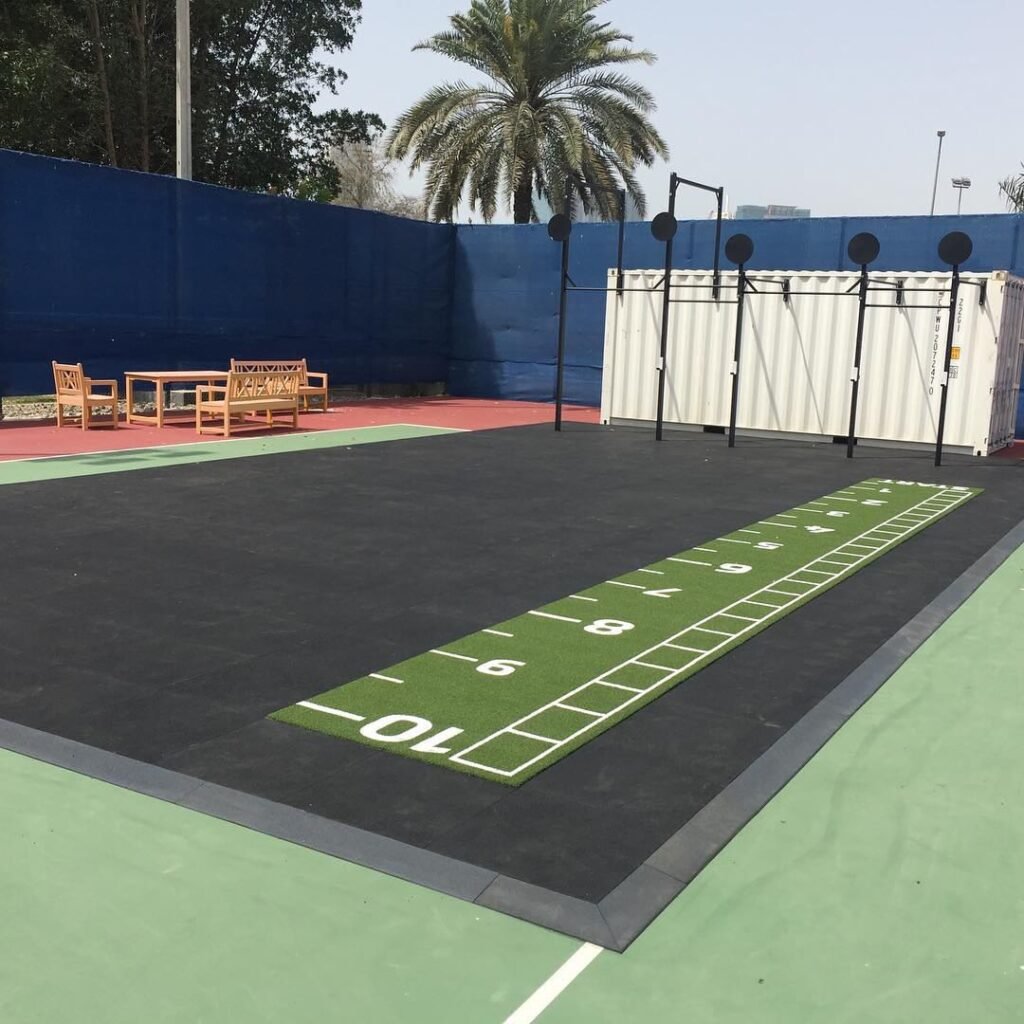
Challenges and Solutions in Rubber Flooring
While rubber flooring offers numerous benefits, from durability to water resistance, like all materials, it isn’t without its challenges. However, understanding these challenges and how to address them can prolong the life of your rubber flooring and maintain its appearance and functionality.
What are the common disadvantages of rubber flooring?
Rubber flooring, despite its many advantages, has certain downsides:
- Cost: High-quality rubber flooring costs more than other materials. This initial cost, however, can be offset by its longevity and durability.
- Odor: Especially when new, rubber flooring can emit a distinct odor, which, however, tends to dissipate over time.
How long can one expect rubber mats to last?
The lifespan of rubber mats largely depends on their usage and the quality of the product. Under standard conditions:
- Domestic Use: High-quality rubber mats can last over 20 years in homes where foot traffic is moderate.
- Commercial Use: In commercial settings with heavy footfall, rubber mats may have a reduced lifespan but can still serve effectively for 10 to 15 years.
- Maintenance: Proper care, which includes regular cleaning and avoiding exposure to sharp objects or harmful chemicals, can significantly extend rubber mats’ life.
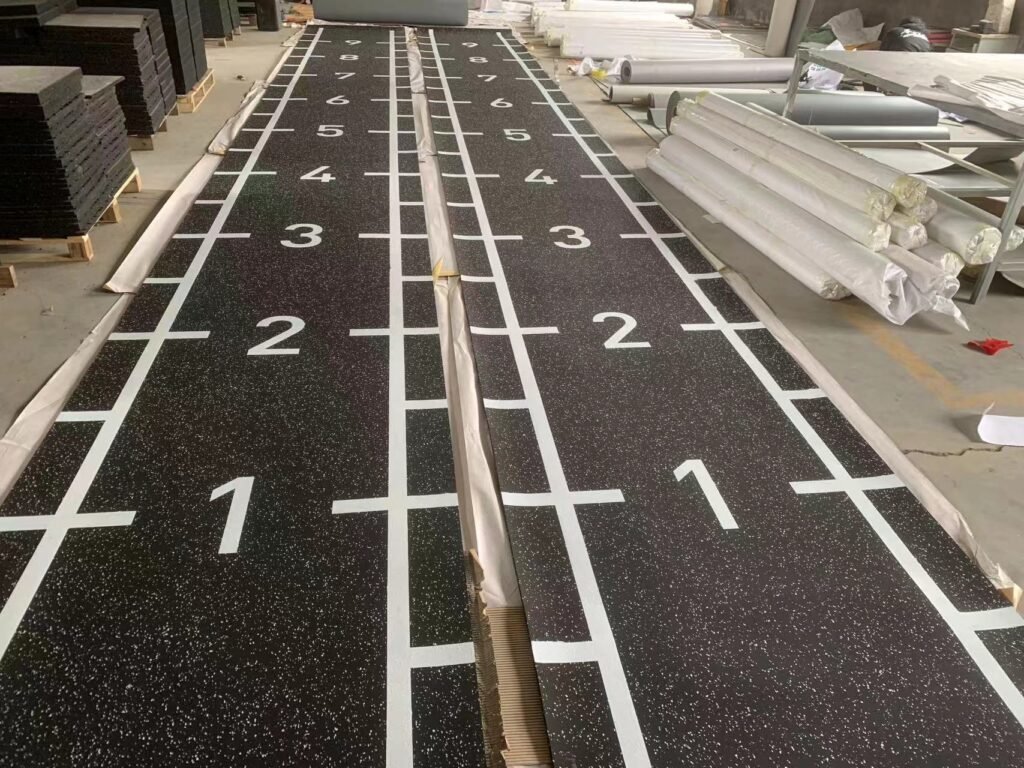
Do I need a vapor barrier under rubber flooring?
Using a vapor barrier under rubber flooring can be beneficial, especially in moisture-prone areas:
- Prevention: A vapor barrier prevents moisture from seeping through the subfloor to the rubber, ensuring longevity.
- Mold & Mildew: It reduces the chances of mold and mildew forming between the subfloor and the rubber.
- Protection: In basements or ground-level installations, vapor barriers provide additional protection against ground moisture.
Handling mold, mildew, and odors in rubber flooring.
While rubber is resistant to moisture, it isn’t entirely immune to mold, mildew, and the odors it can produce. Addressing this is crucial:
- Regular Cleaning: Use a mild detergent and water solution to clean the rubber flooring, ensuring it remains free from organic materials that might promote mold growth.
- Adequate Ventilation: Ensure the room has proper ventilation to prevent moisture buildup.
- Address Spills: Attend to any spills promptly. While rubber is water-resistant, prolonged exposure can be problematic.
- Odor Control: If your rubber floor emits an odor, using a mixture of equal parts white vinegar and water can help neutralize it. Ensure to rinse thoroughly afterward.
In essence, while rubber flooring presents particular challenges, with the proper knowledge and a proactive approach, you can easily surmount these obstacles, ensuring your floor remains a long-lasting and aesthetically pleasing part of your space.
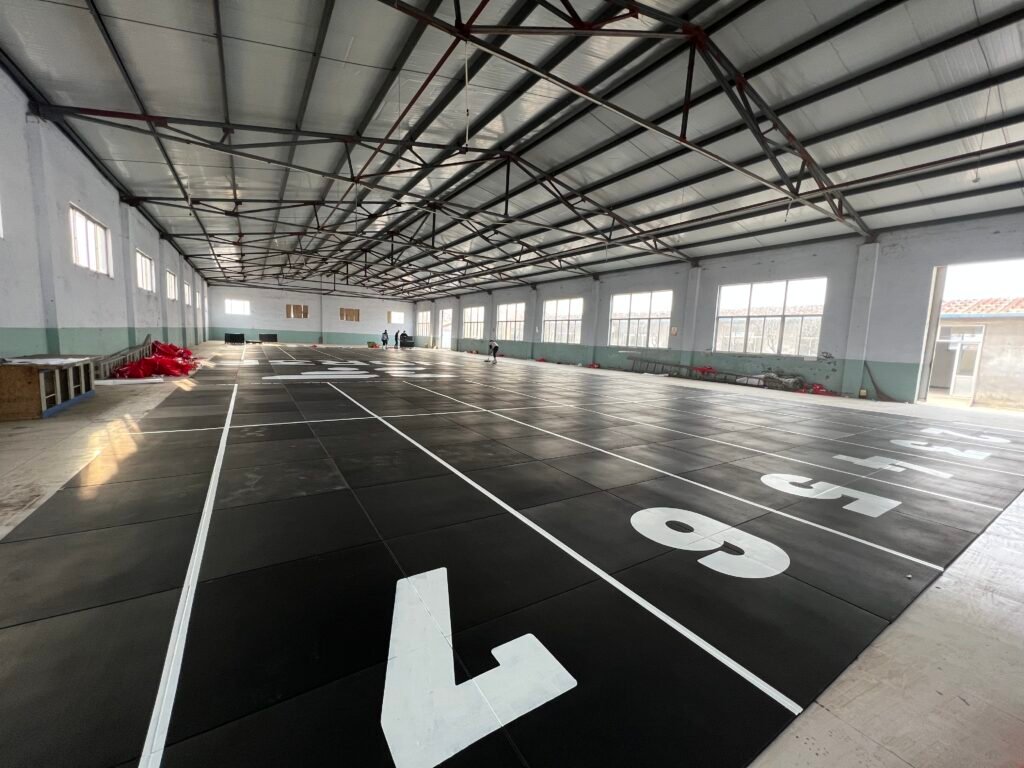
Beyond Waterproofing: Other Benefits of Rubber Flooring
Rubber flooring is hailed for its waterproof properties, but this remarkable material offers much more than water resistance. From safety to style, rubber flooring is a preferred choice for various applications, providing functional and aesthetic benefits.
H3: Rubber flooring for shock absorption: Why it matters.
One of the standout features of rubber flooring is its ability to absorb shock. Here’s why this attribute is essential:
- Safety: A shock-absorbent floor minimizes the impact of falls, making rubber a top pick for places with a higher risk of slips, such as bathrooms or commercial kitchens.
- Gym and Sports Facilities: The flooring in these places undergoes significant stress due to heavy equipment and intense activities. Rubber flooring reduces strain on athletes’ joints and minimizes equipment wear.
- Sound Insulation: Rubber’s shock-absorbing quality also helps dampen noise, providing sound insulation — a boon for busy homes or commercial spaces.
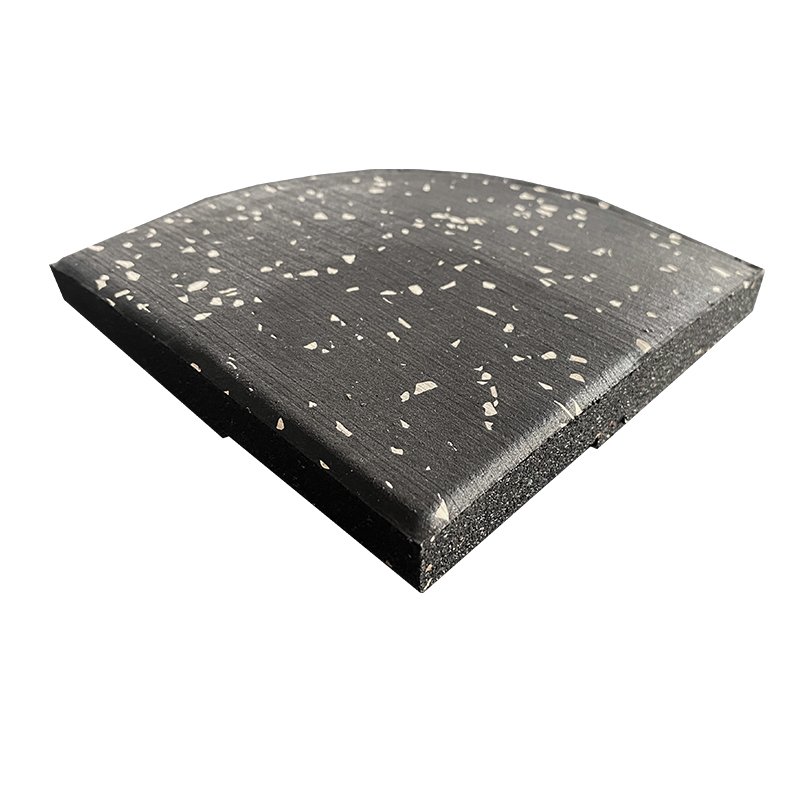
Choosing rubber flooring for kids, spas, and pools.
The inherent properties of rubber make it an excellent choice for specific areas:
- Kids: Rubber flooring is not only durable but also soft, making it perfect for kids’ rooms and play areas. It’s easy to clean, and its shock-absorbent nature reduces the chances of injuries.
- Spas: In an environment where water spills occur daily, rubber flooring ensures slip resistance, safety, and easy maintenance.
- Pools: Around swimming pools, where wet and slippery surfaces are standard, rubber flooring offers a non-slip surface, reducing accidents and providing comfort underfoot.

Making a stylish statement with rubber flooring: variety and designs.
Gone are the days when rubber flooring was only about functionality. Today, it’s about making a style statement:
- Variety: Rubber flooring is available in many colors, patterns, and designs, suitable for any interior design aesthetic.
- Customization: Modern rubber flooring options allow for unique patterns and designs, enabling homeowners and businesses to create distinct spaces.
- Integration with Other Materials: Rubber can be seamlessly combined with wood or tiles, allowing for design fluidity and creating captivating visual effects.
In conclusion, while rubber flooring’s waterproof qualities are undoubtedly a highlight, it’s its versatility, safety, and design potential that makes it a sought-after flooring option in modern interiors.
Installation and Care for Rubber Flooring
Rubber flooring combines resilience with aesthetics, making it a popular choice for various settings. However, to ensure longevity and optimal performance, proper installation and care are crucial. This guide delves into the essential aspects of installing and maintaining rubber flooring to help you get the most out of your investment.
How do you install rubber flooring rolls for optimum performance?
Installing rubber flooring rolls requires precision to achieve a seamless look and superior functionality:
- Preparation: Start with a clean and level subfloor. Remove any debris or old adhesive residues to ensure the rubber adheres appropriately.
- Measuring: Accurately measure the room dimensions and cut the rubber rolls accordingly. It’s advisable to leave a slight excess, which can be trimmed after installation.
- Adhesive: Use a suitable adhesive for rubber flooring. Spread it evenly on the subfloor and lay the rubber roll on top, pressing firmly to remove air bubbles.
- Seams: Seams will be necessary for areas more expansive than the roll. Ensure they align perfectly, and use a recommended seam sealer for a watertight finish.
- Trimming: Once the adhesive has been set, trim any excess material using a sharp utility knife for a clean finish.
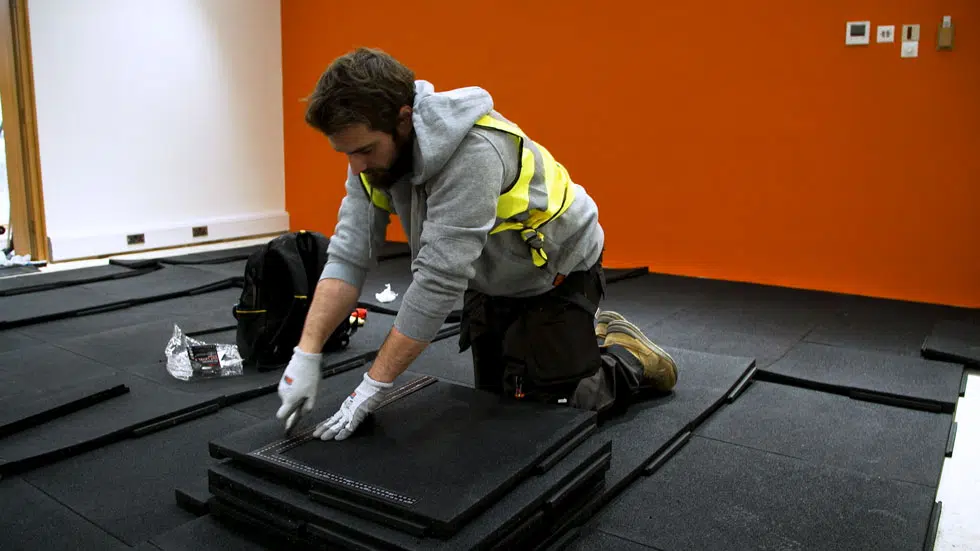
Can foam tiles get wet, and how do they compare with rubber tiles?
Foam tiles are another versatile flooring option, but there are crucial distinctions to note:
- Water Resistance: While foam tiles are moisture-resistant, they are not entirely waterproof. If exposed to excessive water, they might absorb it, leading to potential mold issues.
- Durability: Rubber tiles generally offer superior durability compared to foam tiles, especially in high-traffic areas
- Feel and Comfort: Foam tiles are softer underfoot, making them ideal for play areas for kids or spaces where people might be standing for extended periods.
- Maintenance: Foam tiles can be easily cleaned with a damp cloth or mild detergent. However, they might stain if exposed to certain chemicals. On the other hand, rubber tiles are resistant to most chemicals and can be cleaned similarly.
- Installation: Foam and rubber tiles often come with interlocking designs, making installation relatively easy without needing adhesives.
What steps should be taken to protect rubber tiles from damage?
To ensure the longevity and appearance of rubber tiles:
- Regular Cleaning: Dust and dirt can act as abrasives. Regular sweeping or vacuuming will prevent undue wear.
- Deep Cleaning: Periodically clean with a mild detergent and water solution, ensuring no residue is left behind.
- Avoid Sharp Objects: While rubber tiles are durable, sharp objects can cause cuts or gouges. Be cautious when moving furniture or heavy equipment.
- Address Spills: Clean up any chemical or oil spills immediately to prevent staining or degradation of the rubber material.
In conclusion, rubber flooring, when installed and cared for correctly, offers a blend of durability, aesthetics, and functional benefits. Following these guidelines will ensure your rubber flooring remains in top condition for years.
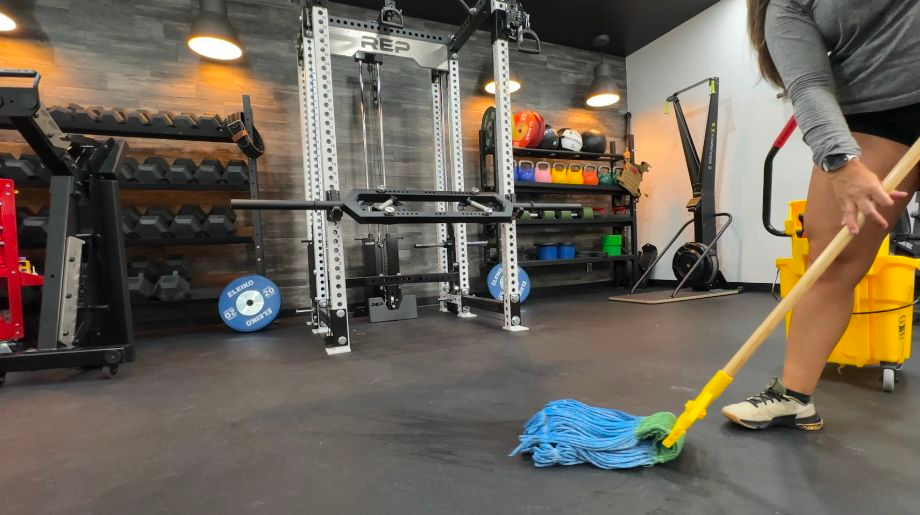
Making an Informed Choice
In the flooring world, rubber stands out for its resilience, versatility, and aesthetic appeal. However, like any other product, making an informed decision is essential based on your specific needs, budget, and the myths surrounding it. This guide aims to shed light on these aspects to help you make the best choice.
How to match the correct type of rubber flooring to your demands
Choosing the ideal rubber flooring requires an understanding of its varieties and your specific requirements:
- Identify Your Needs: Are you looking for flooring for a high-traffic area? Do you need sound insulation, shock absorption, or something easy to maintain?
- Indoor vs. Outdoor: Rubber flooring for outdoor use must be more durable and resistant to elements than indoor ones.
- Texture and Finish: From smooth finishes to those with textures for anti-slip properties, rubber flooring comes in several styles. The right choice would depend on where you’re installing it.
- Thickness: Areas that require more cushioning, like gyms, would benefit from thicker rubber flooring.
- Aesthetics: With various colors and patterns available, decide on what matches the overall design theme of your space.
Common misconceptions about rubber flooring: separating fact from fiction
- “Rubber flooring always smells“: While there’s a distinctive odor when rubber flooring is first installed, this dissipates over time and can be minimized with proper ventilation.
- “It’s not eco-friendly“: Many rubber floorings are made from recycled materials, making them a sustainable choice.
- “Maintenance is challenging“: Contrary to this belief, rubber flooring is easy to maintain. Regular sweeping and occasional mopping keep it looking new.
- “Only suitable for commercial spaces“: With advancements in design and style options, rubber flooring has found its place in residential settings, from kitchens to basements.

In the end, the key to a successful flooring project is research. Understanding the nuances of rubber flooring, knowing where to find the best deals, and distinguishing between myths and facts will ensure that your investment is sound, both functionally and aesthetically.
Rubber flooring is a testament to the blend of durability, aesthetics, and practicality. From understanding its waterproof nature to diving deep into its myriad applications and characteristics, it’s evident that rubber flooring offers versatile solutions for diverse needs. Whether outfitting a commercial space, renovating a home, or seeking the perfect gym floor, rubber is a reliable choice. As with any decision, being well-informed and discerning will ensure that your investment in rubber flooring not only meets but exceeds your expectations. In the ever-evolving flooring world, rubber continues to make its resilient mark.


